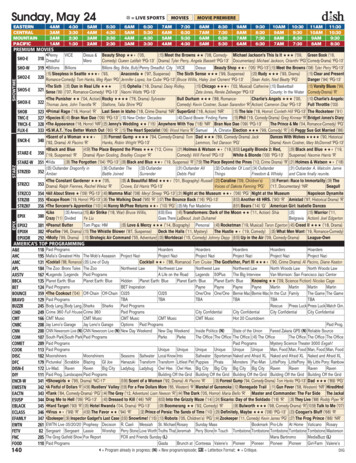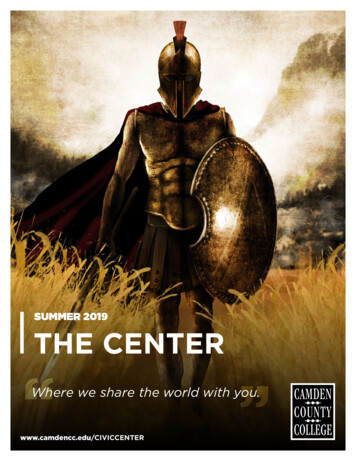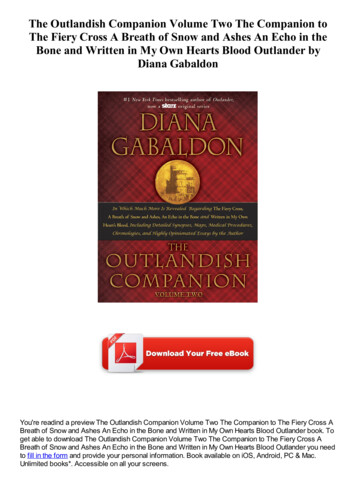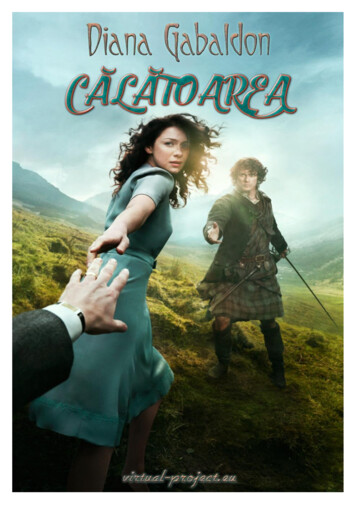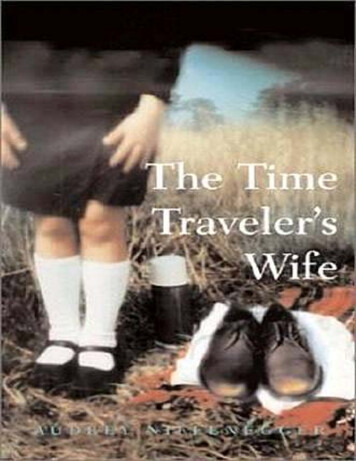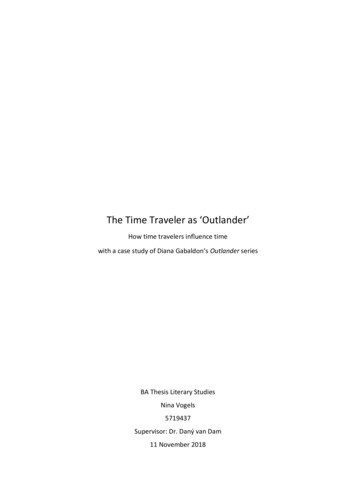
Transcription
The Time Traveler as ‘Outlander’How time travelers influence timewith a case study of Diana Gabaldon’s Outlander seriesBA Thesis Literary StudiesNina Vogels5719437Supervisor: Dr. Daný van Dam11 November 2018
AbstractThe aim of this thesis is to find out what the impact of time travelers on the past is in fiction,with a case study of the first three books of the Outlander series by Diana Gabaldon. In thesenovels, the protagonist Claire accidentally travels over two hundred years into the past andhas to adapt to the differences between what she is used to in the twentieth century and theway society works in the eighteenth century. She has knowledge of the future and becauseof this she wants to change it. Supported by theories concerning time travel by Paul Nahinand David Lewis and concepts like the grandfather paradox, this thesis researches if fictionaltime travelers can change the future when they travel into the past, and what they can do.The first two sections consist of a discussion about time and time travel and the differencesthat the time traveler encounters. These are followed by a the third part which discusses ifthe time traveler can change or influence the future. The thesis concludes that time travelerscannot change the future, because it already happened, but that they can influence thefuture because of their knowledge. However, it is shown that having knowledge is notalways a blessing. It can cause doubts for the time traveler and distrust from the people ofthat time.
Table of contentsIntroduction. 4History and Outlander . 6What is time travel? . 7Differences . 11Changing the past . 15The grandfather paradox. 18Conclusion . 21Bibliography. 23
Introduction“To travel in time. Could there possibly be a more exciting, more romantic, more wonderfuladventure than that?” (Nahin, Time Machine Tales 1). With these words, Paul Nahin openshis book Time Machine Tales: The Science Fiction Adventures and Philosophical Puzzles ofTime Travel. Indeed, who does not want to be able to travel in time and see what happenedin the past and know what the future will bring? Therefore, it is not surprising that storiesabout time travel are popular (Nahin, Time Machine Tales 2-3). Novels in which time travel ispossible are worth to do research on, because there are no limits to what is possible sincetime travel is only speculation. Anything can happen in time travel novels. It can bring peoplewho are long dead back to life, and events can be relived. Paradoxes, the complications ofchanging the future and playing with chronology are three other features of time travel innovels that are relevant for literary studies, because in time travel, the chronology of eventscan deviate. Therefore, this thesis will explore some aspects of time travel and what canhappen in time travel stories, with a case study of the first three novels of the Outlanderseries by Diana Gabaldon. These are Outlander (1991), Dragonfly in Amber (1992) andVoyager (1994). There are five more novels in this series, with a ninth book on the way(Gabaldon, Go Tell the Bees That I Am Gone). In addition, there are several prequels andshort stories that are set in the same world (Gabaldon, Chronology of the Outlander Series).The Outlander novels are currently being adapted into a television series, with the first threeseasons already broadcast as of October 2018, and at least three more seasons to go (IMDb).I have chosen these three novels because they are connected. They tell the story ofthe first journey of the protagonist, Claire, into the past. In Outlander, Claire is on her secondhoneymoon with her husband Frank Randall in Scotland, in 1945.1 She accidentally travelsinto the past through a circle of standing stones and appears in 1743. To protect her from anEnglish dragoon, Jonathan Randall, she has to marry James (Jamie) Fraser to make her aScottish citizen and she falls in love with him. She starts to care for the people she meets in1In the United States version of Outlander, the ‘present’ for Claire and Frank, from where Claire departsthrough the stones, is 1945, while in the United Kingdom version, it is 1946. According to Diana Gabaldon, ReayTannahill, a Scot, made her aware that 1946 seemed a more probable year for the novel, given circumstancesin Scotland as Gabaldon showed them. However, it was too late to change the date in the version of the UnitedStates, while it could still be changed in the United Kingdom version. For this thesis, the United States version isbe used of all three novels and therefore, when Claire travels through time, it is regarded as 1945 (Gabaldon,FAQ).4
the eighteenth century and she warns Jamie about the Jacobite rising which will end in theBattle of Culloden, in 1746. In this battle, many Scottish men will be killed and life in theHighlands will be changed forever. In Dragonfly in Amber, she sets out to prevent theJacobite rising from happening, together with Jamie. A part of Dragonfly in Amber andVoyager describes the Battle of Culloden and the aftermath of the battle and thus if Jamieand Claire managed to change the future.This case study is relevant for the thesis question, which asks what the impact of timetravel into the past is in fiction. It will discuss if – and how – time travelers can change orinfluence the future because of their knowledge. Outlander is a relevant case study becauseit is about a woman who wants to change history as she learned it. To answer the question,this thesis consists of three sections. The first one focuses on time travel theory, and morespecifically, how it can be applied to the Outlander series. In the second part, time travel willbe discussed with regard to the novels. The corresponding sub question regards how welltime travelers, like Claire in Outlander, fit into the time they visit. The third part will focus ona specific paradox concerning time travel into the past: changing the past. The sub questionthat is treated in this part of the thesis is: can the past be changed, and if so, how? Claire isnot the only time traveler from the twentieth century who arrives in the eighteenth century.Geillis, another time traveler, traveled on purpose into the past to help the Jacobite rising.Claire, on the other hand, wants to prevent it. They both want to change history, becausethey both know that many Scots will be killed in the final battle and the consequences thiswill have for Scotland and its citizens. Can they change the past, or do they make the pastcome true? This part also discusses one particular paradox in time travel theory, thegrandfather paradox, which concerns the question if it is possible to change the past, as well.In this thesis, time travelers are assumed to be ‘outlanders’: people who do notbelong in a time and a place because of the differences between their own culture and theother culture that they encounter. Nahin describes in his books Time Machines: Time Travelin Physics, Metaphysics and Science Fiction and Time Machine Tales many differences thatdifferent time travelers have to deal with. He discusses general time travel theory, with afocus on traveling through time in machines. Although the time travelers in Outlander do nottravel by machine but through ‘magic’, his overview of the problems that time travelersencounter during their travels because of the differences between times and cultures, isuseful for my analysis. Because time can be measured in different ways, and because it is5
difficult what exactly the present, past and future are in a time travel story, David Lewis’article “The Paradoxes of Time Travel” will be used as well. His focus lies on what the past isand how time works, which contributes to the clarifying of what the present is in time travel.History and OutlanderWhile the Outlander series is fictional, some of the events described in the novels haveactually taken place. In 1745 and 1746, the Scots fought for Charles Edward Stuart to reclaimthe throne. The rebellion ended in disaster for the Jacobite clans in 1746 (Haywood 122123).What makes the aspect of time travel in Outlander so appealing, according to JamesCateridge, is that time travel is used to return to a time “before a national trauma takesplace, and the possibility of a different past and therefore present and future” (Cateridge10). This national trauma in Outlander is the Battle of Culloden (Cateridge 10), in which manymen died and which had severe consequences on the life of the Scottish people afterwards.Haywood describes the measures that were taken to ensure that the clan system lost itspower. The lands of the clan chiefs who took part in the rebellion were seized and the powerof the other clan chiefs was limited. What we now perceive as ‘Scottish’, “playing bagpipes,wearing highland dress and speaking Gaelic” (Haywood 123), was forbidden. Furthermore,to ensure that no uprising would be possible in the future, English garrisons were stationedin the Highlands until the nineteenth century (Haywood 122-123). Afterwards, the ‘HighlandClearances’ disrupted the old clan system even more by evicting Highlanders from theirlands (Haywood 124-125).6
What is time travel?This thesis will first discuss what time travel is, how it works, and define what the past,present and future in time travel are. The present can, for example, be the time where thetime travelers originally come from, but also the time that they arrive in. In the case ofOutlander, Claire travels from 1945 to 1743, so both years are at one point her present.What is the past at her departure, becomes her present and her future. As the tagline of theTV series adaptation aptly states: “[w]hat if your future was the past?” (Cateridge 3). Toavoid confusion in this thesis, the eighteenth century is regarded as Claire’s present, becausethat is where most of the events happen in the novels that are discussed here. Then remains1945: is that the past or the future? Because 1945 is Claire’s past, it will be regarded as such,with everything between 1743 and Claire’s past as the future. However, when Claire is in theeighteenth century, life in the twentieth century goes on. The next paragraph will explainhow this works.Lewis provides insight as to how this difference in time may work. He diserns externaltime and personal time. He defines external time as “time itself” (Lewis 146), while personaltime is “that which is measured by [the time traveler’s] wristwatch” (Lewis 146). Thisassumes that the wristwatch is infallible, and for a time traveler, if he has travelled, say, anhour, the wristwatch records an hour, whether he arrives years into the future or into thepast (Lewis 146). In Outlander, then, the personal time of both Claire and Frank continueseven when Claire travels into the past. She is in the past for about three years, and duringthat time, Frank’s life in 1945 continues as well. For him, not being a time traveler, theexternal time is the same as his personal time. Claire, however, travels almost two hundredyears into the past, and a few years later, she travels back (and twenty years later, she goesback to the past again, to find that about twenty years have passed there, as well).Therefore, Claire’s personal time is non-linear because of her time travels, for which Lewisuses the following metaphors:We may liken intervals of external time to distances as the crow flies, and intervals ofpersonal time to distances along a winding path. The time traveler’s life is like amountain railway. The place two miles due east of here may also be nine miles downthe line, in the westbound direction. (Lewis 147)7
Therefore, in order to understand how the two different kinds of measuring time work, itcan be said that the external time indeed continues, which accounts for the fact that inOutlander, time goes on in the twentieth century, while it also does so in the eighteenthcentury. It is linear, and therefore, when Claire is in the past, time passes at the same speedas it does in the twentieth century. This also explains why the same amount of personal timepasses for both Claire and Frank in the nearly three years that Claire is gone.Contradictory to this linear perspective of Claire’s time, however, is how time worksfor Gillian. She travels from 1968 to several years before 17432, and when Claire arrives inCastle Leoch, Gillian had changed her name to Geillis and was already married to ArthurDuncan. In 1743, when she is tried for witchcraft and condemned to death, she hadmanaged to divert nearly 10,000 pounds for the Jacobite cause. Shortly after Gillian’sdeparture into the past, Claire goes back into the past as well, for the second time. For Claireagain, time has passed in a linear way, because around the same amount of time has passedin the eighteenth century as has when she was in the twentieth. But Geillis does not travelthe same amount of years into the past as Claire, which indicates that time does notnecessarily have to work the same for different people.What is typical about a time travel story, is that it can cause paradoxes. One examplefrom Outlander is that Claire is alive in 1743, years before she was born. She is married in thetwentieth century, but her husband Frank is also not born yet in the eighteenth century.Claire explains this in the eighteenth century by saying that her husband is dead. Nahinargues that in time travel stories, paradoxes can indeed occur. He defines a paradox asfollows: “[a] paradox, according to the usual dictionary definition, is something that appearsto contain contradictory or incompatible parts, thus reducing the whole to seemingnonsense. And yet, truth is also evident in the whole” (Nahin, Time Machine Tales 189). Theparadox here is that Claire is alive in a time when she is not yet born, and married tosomeone who is not born yet, either, but he is also not dead. In Outlander, there is truth tothis, but it is also contradictory.2The time travel of Geillis also has two different years in the novels, as does Claire’s departure. In Outlander,Dougal tells Claire a message from Geillis, “one, nine, six, and seven” (Gabaldon, Outlander 691). It wasespecially important that he did not change the order of the numbers, because in this way, Geillis tells Clairefrom what year she came: 1967 (Gabaldon, Outlander 691). However, in Dragonfly in Amber, Claire goes backto Scotland in 1968 and sees Gillian stepping through the stones (Gabaldon, Dragonfly in Amber 940-941).Because 1967 is just mentioned once and most of Dragonfly in Amber is set in 1968, I will use 1968 as the dateof Gillian’s departure.8
Outlander, however, is not a “standard” time travel story. There are two timetravelers, Claire and Gillian, who travel independently from each other through the samestanding stones. Neither travels through time with a time machine. These machines arefrequently used in stories about time travel, as Nahin’s books show. This also accounts forone of the genres in which time travel generally occurs, which is science fiction (Wittenberg26). Outlander instead is, according to Gabaldon, difficult to put into just one genre. Shedeclares that it is not ‘romance’; she prefers just the label ‘fiction’ on them (Gabaldon, FAQ).Claire travels involuntarily through time. She hears a noise coming from the stones,and when she steps through a cleft stone, she is thrown backwards in time (Gabaldon,Outlander 49-50). Because Claire does not travel voluntary or with a machine, she has noidea that she travelled through time, until the evidence that she arrived in the eighteenthcentury becomes too much to ignore (Gabaldon, Outlander 71). The Scottish men sheencounters are all wearing kilts and they use words like “musket ball” and “chirurgeon”(Gabaldon, Outlander 59; 62). Her wonder at these words indicate that they did not belongin 1940’s English vocabulary. Another piece of evidence are the city lights of Inverness,which are missing in the eighteenth century (Gabaldon, Outlander 67). Lastly, Claire meetsJonathan Randall, whom her twentieth-century husband Frank regards as his ancestor. Shedoes not recognize Jonathan Randall (except that he looks a lot like Frank), which makes herwonder who he is, because she thought that she had already met all of Frank’s British familymembers. Moreover, Jonathan Randall’s sword looks very authentic for a movie prop,because Claire’s first thought upon arriving in the eighteenth century is that she hasstumbled into a battle scene on a movie set (Gabaldon, Outlander 51-54). Her arrival atCastle Leoch, with its primitive conditions and her room without electrical fittings (Gabaldon,Outlander 81; 90-91), confirms her suspicions, however irrational they may be: she arrived inthe eighteenth century.Because Claire is not used to these examples, she is more of an ‘outlander’ thanother time travelers who might have been able to prepare themselves for their journey.They might have been able to learn the language and customs of that time, like GeillisDuncan. Geillis traveled voluntarily through the stones because she wanted to changehistory and help the Jacobite rebellion to succeed. Since there are many years betweenClaire’s departure in 1945 and arrival in 1743, there are bound to be differences in the9
culture, morals and knowledge of that time. In the next part, these differences will bediscussed in more detail.10
DifferencesIn Outlander, Claire is regarded as a ‘Sassenach’, which means an English person, or an‘outlander’ (Gabaldon, Outlander 6). She is in more ways an outlander than just being anEnglish person, because she is not, certainly when she arrives, adapted to customs in theeighteenth century. Nearly two hundred years difference in time accounts for differences inhabits. These differences are there regardless of the country the time traveler, in this caseClaire, arrives in, whether it is her own country, England, or another, Scotland. Some ofthese differences are more significant, for example those that will impede her medicalabilities. She has the knowledge, but not the tools that are necessary to perform thetreatments. Other differences are Claire’s own behavior and speech, and the values that sheis used to in the twentieth century.There is a difference between medical knowledge in the past, present and future. In1945, the knowledge of medicine and healing is much more advanced than it is in 1743. Inthe Second World War, Claire was trained as an army nurse and she developed an interest inmedicinal plants after the war. However, even though she has all this knowledge, sheencounters many difficulties in treating people in the eighteenth century: she sometimesknows that things can be treated with modern medicine, in a hospital. Since she does nothave access to that, she is not able to help everyone. A case like this happens during a boarhunt, where a man’s intestine is punctured. In the 1940’s, he would have had a chance atsurvival. However, without an operating room and antibiotics, with only eighteenth-centurymedicine, his death was inevitable (Gabaldon, Outlander 195-196). Nahin supports thisdifference in medical abilities with an example about a time traveler who travels into thepast, but who has tuberculosis. At that certain point in the past that the time traveler arrivedin, it was untreatable because knowledge was not yet as advanced as it was in the time thatthe time traveler came from, where it was treatable (Nahin, Time Machines 18-19). Anothertime traveler has their appendix removed before undertaking the journey to the past,because that could not be done then, either (Nahin, Time Machine Tales 5). Anotherexample where Claire knows what to do, but the necessary supplies are not at hand – oreven known – is when Claire treats Jamie’s shoulder, right after arriving in the eighteenthcentury when she is still confused about what happened, and she has not yet come to termswith her fate:11
“The wound needs to be disinfected first, then bandaged with a clean cloth, if thereare no sterile bandages.” Eyebrows rose all around. “Disinfected?” said the smallman, carefully. “Yes, indeed,” I said firmly, thinking him a bit simple-minded, in spiteof his educated accent. “All dirt must be removed from the wound and it must betreated with a compound to discourage germs and promote healing.” “Such as?”“Such as iodine,” I said. Seeing no comprehension on the faces before me, I triedagain. “Merthiolate? Dilute carbolic?” I suggested. “Or perhaps even just alcohol?”Looks of relief. At last I had found a word they appeared to recognize. [ ] I knew theHighlands were primitive, but this was nearly unbelievable. (Gabaldon, Outlander 6465)After this incident, Claire soon learns what to say to make people understand her, becausesome of the supplies that she needs are available in the eighteenth century, just not underthe same name as it is in the twentieth. Another difference is what healers do when there isan infection. There is a moment when Claire sets Jamie’s fingers instead of amputatingthem. While it had not even crossed her mind to amputate Jamie’s fingers, he had expectedto lose them. Claire then remembers the chest of Davie Beaton, Castle Leoch’s healer whodied before Claire came to 1743, which was full of saws and knives that he used foramputating, which was common in a time when there were no antibiotics that could be usedagainst infections (Gabaldon, Outlander 140; 838-839). Lastly, there is a problem withhealing that Claire herself encounters: when she gets pregnant, Jamie sends her backthrough the stones right before the battle of Culloden (Gabaldon, Dragonfly in Amber 892894). Had he not done that, if Claire had remained in 1746, both she and the child wouldprobably not have survived the birth, but in the twentieth century, they did (Gabaldon,Dragonfly in Amber 897).The difference in treatment of women also changes in the course of history. In theeighteenth century, women had a place in society that is different from what Claire was usedto in the eighteenth century, especially because of her work during the war. In theeighteenth century, women had to listen to their father or husband. According to CarolDonelan, “Claire [ ] perceives the laws regulating life in the eighteenth century as unjust”(Donelan 41). In Scotland in the eighteenth century, when a woman marries, she becomesthe property of her husband and before the marriage, she belonged to her father (Donelan12
41-43). This is shown through Laoghaire, whose father demands a punishment because ofher “loose behavior; consortin’ improperly wi’ young men against [her father’s] orders”(Gabaldon, Outlander 110). As Claire came alone to the eighteenth century, she is freebefore her wedding to Jamie, but she becomes his property. Through their wedding, Clairealso becomes a Scottish citizen. However, Claire does not listen to Jamie’s orders andbecause of that, she brings the men of the Clan MacKenzie in danger. When she tries toescape back to Craigh na Dun, she gets caught by an English Corporal, who takes her toCaptain Randall at Fort William. Jamie and the other MacKenzies come to save her,endangering their own lives. Claire remarks on this to Jamie:“It’s your own fault, for ignoring me and suspecting me all the time [of being a spy]! Itold you the truth about who I am! And I told you there was no danger in my goingwith you, but would you listen to me? No! I’m only a woman, why should you pay anyattention to what I say? Women are only fit to do as they’re told, and follow orders,and sit meekly around with their hands folded, waiting for the men to come back andtell them what to do!” (Gabaldon, Outlander 385)After a tense dinner, Jamie punishes Claire because he is her husband and therefore he isexpected to be the one to carry it out. Once Claire is punished by Jamie (which everyonecould hear), the MacKenzies accept Claire again (Gabaldon, Outlander 392-394). Thisexample shows that Claire disagrees with how women are regarded: that they should onlylisten to the men, and that their opinion is not valued. Claire’s opinion is later going to bevalued, at least by Jamie, once he understands that she comes from another time, and byother people as well, once she is able to prove her knowledge of healing.Another matter, but one that is connected to the previous argument, is that Claire’sspeech is not considered as womanly behavior. Claire shouts “[b]loody fucking hell”(Gabaldon, Outlander 16) when she accidentally drops a teapot in someone’s lap in thetwentieth century. Frank then, as her husband, apologizes for her, saying that she learned itin her time at the field hospitals during the Second World War (Gabaldon, Outlander 15-16).In 1743 it is considered even worse. She calls Jamie a “goddamned bloody bastard”(Gabaldon, Outlander 76), whereupon one of the MacKenzie men in Jamie’s companyremarks that “I’ve ne’er heard a woman use such language in me life” (Gabaldon, Outlander13
76). One of the other men says “Your husband should tan ye, woman” (Gabaldon, Outlander77). These reactions show two things. First, that Claire’s cursing is not common in her owntime, but even less so in the eighteenth century. The second thing is that the last remarkagain shows how men are in charge of women, how a woman is the property of herhusband, and therefore it is the husband who should teach her not to use such language.In all the examples described above, Claire’s behavior is regarded as uncommon bythe eighteenth-century Scottish people, but their behavior is also strange to Claire. Indeed,the time traveler’s habits can be regarded as unusual by the people of the current time theyare in, but the behavior of the other people can be different from what the time traveler isused to, as well. It is important to note that because of Claire’s healing abilities, however,she is accepted more easily. The longer she is in the eighteenth century, the better she fitsin, because she adapts to the time as well as she can. There are also women like Mrs. Fitzand Geillis Duncan who accept her more easily than other women. Her marriage to Jamieand thus becoming a Scottish woman helps in the acceptance by the men of the clan.However, throughout the first two books, she continues to be regarded, or even feared, as awitch. Therefore, she seemed to fit in better in the Scotland of her own time. Nahin supportsthis by giving an example which claims that a home belongs more to time than to space: atime traveler would feel more at home in their own time in a different country, than in theirown country in a different time (qtd. in Nahin, Time Machines 24).14
Changing the pastA question concerning time travel is if it is possible to change the past. If someone goes backin time, what consequences can that have? It would be impossible for a time traveler not toleave a trace, however careful they may be. There are two things that can happen: thosetraces can have consequences, or not. In the first case, the time traveler may do somethingthat can change the future. When they get back to the future, they can find the futuredifferent than it was when they departed. The other option is that the traces left by timetravelers have no consequences, because the future cannot be changed. This last option iswhat several critics argue in favor of, and this is also what happens in the first threeOutlander novels.In Outlander, Claire tells Jamie wat is going to happen in the future. She tells himabout the bad things that are to come, like the Jacobite rising and the famine, but she alsotells him about benefits of the twentieth century, like cars. Together, Claire and Jamie try toprevent the Jacobite rebellion by ensuring that Charles Edward Stuart, also known as BonniePrince Charlie , does not get the much-needed financial means to wage war. However, whenClaire and Jamie are back in Scotland, Jamie receives a letter, in which Charles writes toJamie that he is going to reclaim the throne. Because there was not enough time for a letterto reach Jamie and get back to Charles, Charles himself added Jamie to the list of Jacobitechiefs, thereby making Jamie a traitor to the English crown and giving him no choice but totake part in the rebellion (Gabaldon, Dragonfly in Amber 583-584). The first battle, that ofPrestonpans, went exactly as Claire knew from her history book: the Jacobites win with fewcasualties. The Battle of Culloden was lost by the Jacobites, which she also knew wouldhappen. With all Jamie’s and Claire’s work to prevent it, Charles Edwart Stuart went to warand as a result, the Jacobites lost the rebellion. History as Claire knew it, has indeed takenplace. Claire and Jamie had not been able to change it. A few things can be concluded fromtheir inability to change the future.The first is that it is impossible to change the past – or the future, depending onwhere the time traveler is. Several critics agree on this fact, but they have differen
series by Diana Gabaldon. These are Outlander (1991), Dragonfly in Amber (1992) and Voyager (1994). There are five more novels in this series, with a ninth book on the way (Gabaldon, Go Tell the Bees That I Am Gone). In addition, there are several prequels and short stories that are set in the same world (Gabaldon, Chronology of the Outlander .
